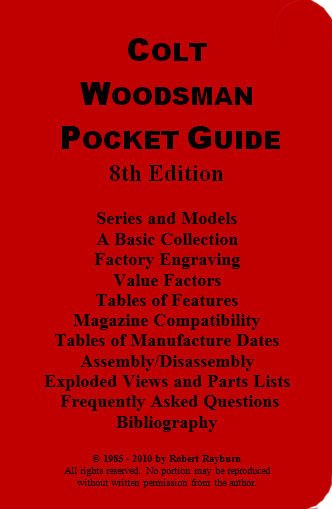Colt Woodsman Pocket Guide |
| A 96 page pocket size copy of this Woodsman Guide is available from the author. Information is included on the Pre-Woodsman, Woodsman Sport, Woodsman Target, Woodsman Match Target, Challenger, Huntsman, and Targetsman. |

|
The 8th edition is now available.
This is the latest and final edition. More information, more pictures, improved layout and organization over previous versions, and greatly improved photos.
Includes:
- Photos and descriptions of all models, from 1915 to 1977
- Photos and descriptions of how to distinguish the first, second, and third series
- Photos showing how to distinguish between the high velocity ammo and standard velocity ammo versions
- Tables of consistent features that enable you to identify components that are not consistent with the serial number or with other parts, such as the "wrong" magazine or grips.
- Short section on factory engraved guns
- Tables of manufacture dates by serial number
- Magazine interchangeability information with photos
- Assembly/Disassembly instructions
- Exploded views and parts lists
- Bibliography
- Frequently Asked Questions
|
All in a convenient, shirt pocket sized format (3-3/4" x 5-1/2"). Based on original research in the factory records at Colt Firearms, and over 40 years of Woodsman collecting. Price is $10, plus $1 for shipping. Cash, check, or money order ok. Paypal and Google Checkout have gotten too demanding and complicated to continue using them.
|
You can order by sending US $11 payment in cash, or a check in US dollars drawn on a US bank, to:
Bob Rayburn
7622 Emerald Dr SW
Lakewood, WA 98498
Please be sure to include your shipping address.
Colt Woodsman Online Guide
Everything that is in my 96 page Colt Woodsman Pocket Guide is available for no charge at this web site. If you would like the convenience of a shirt pocket guide that you can carry to the gun show with you, buy my guide. If you just want to look up some Woodsman information, browse this site. Please remember, however, that this is copyrighted material.
© 1985 - 2020 by Bob Rayburn. Converted to HTML March, 1995. All rights reserved. No portion may be reproduced without written permission from the author.
INTRODUCTION
This document describes the major variations in all models of the Colt Woodsman line, from the beginning in 1915 until production ceased in 1977. Although there are many more variations that are of interest to advanced collectors, those details are far too numerous to include in an abbreviated guide such as this.
For several years I have been working on a book to detail the many variations, complete with extensive photographs. Unfortunately, time has caught up with me. I am now in my 80s, and will probably not live long enough to complete it.
Bob Rayburn
7622 Emerald DR SW
Lakewood, WA 98498
| | 
or email me.
|
This is a collector's guide to the Colt Woodsman, not a value guide. While factors that affect value are listed, this is not intended to be a price guide!
Collecting the Colt Woodsman is a hobby for me, not a business. Please note that I do not do appraisals, so please do not ask me to estimate the value of your gun. I have provided input to the Blue Book of Gun Values for several years, and since 2005 I also contribute to The Standard Catalog of Firearms. Each of these publications is updated annually with Colt Woodsman values and descriptions based on my recommendations to the editor. The two publications are not identical, and each has certain advantages over the other. I recommend that you consult both publications and then make your own appraisal. You can order either one or both by clicking on the links below.
If you order via the links on this page that will help support the cost of maintaining this Woodsman web site, while the cost to you will be exactly the same as if you ordered directly. Your help will be appreciated.
If you do not feel qualified to do your own appraisal with the aid of these books, Blue Book Publications will do a written appraisal for you for only $20. There are links on their web site to their appraisal service. They also have experts available to answer specific questions about almost any type of gun for a small fee.
Woodsman owners usually want to know when their pistol was made, its model and type, and how much it's worth. This guide will not give all the answers for a specific Woodsman, but it will provide you with the basic knowledge to answer those questions yourself.
THE THREE SERIES
There are three series of Woodsman pistols, corresponding to three basic frame designs. First Series refers to all those built on the S frame as it existed prior to and during World War Two. Second Series includes all versions built on the second S frame design from late 1947 until mid 1955, and Third Series means the third S frame design as used from 1955 to the end of regular production in 1977.
First Series (1915-1947)
 |
The first series Woodsman can be easily recognized by its distinctive profile, which resembles the German Luger in the rakish grip angle. The serial number also provides a sure means of identification, since only the first series has no alphabetical suffix.
|
 |
If the serial number is on the frontstrap and contains only numeric characters, with no alphabetical characters, it is a first series. |
 |
If the only alphabetical characters in the serial number are MT, it is a first series Match Target.
|
Second Series (1947-1955)
The Second Series Woodsmans are the only models that have a push button magazine release, as on the Government Model 45. All post-WWII type Woodsmans, both Second and Third Series, have an S suffix to the serial number. Although it is part of the Second Series, the Challenger model, unlike the Woodsman, has a spring catch at the butt and a C suffix to the serial number.
 |
If it has a push button magazine release just aft of the trigger guard, it is a second series. |
 |
If it is marked Challenger, it is a second series. |
Third Series (1955-1977)
All post-WWII type Woodsmans, both Second and Third Series, have an S suffix to the serial number. Challengers, and some early Huntsmans and Targetsmans, have a -C suffix. All Third Series guns have the magazine release on the butt, in the same location as the First Series.

|
If the magazine release is at the heel of the butt, |
| AND |
 |
the pistol has an S at the end of the serial number, |
| Then it is a 3rd Series. |
 |
If it is marked Huntsman, it is a third series. |
 |
If it is marked Targetsman, it is a third series. |
SERIAL NUMBERS
All three post-WWII type Woodsmans: Sport, Target and Match Target, both Second and Third Series, have an S suffix to the serial number. The Challenger has a -C suffix. The Huntsman (third series) replaced the nearly identical Challenger (second series) when the third series was introduced in 1955. The Targetsman, basically a slightly upgraded Huntsman, was added to the line in 1959. The Huntsman and Targetsman both continued with the Challenger serial numbers (-C suffix) until 1969, when the serial numbers of all S frame models then in production: the Woodsman Sport, Woodsman Target, Woodsman Match Target, Huntsman, and Targetsman were integrated and restarted at 001001S. Nowadays those zero prefixes confuse many Woodsman owners who ignore the zeroes and think they have an early, low serial number gun. The zero prefix serial numbers caused another problem when the serial numbers beginning with 001000S reached 099999S and rolled over to 100000S because serial numbers in that range had already been used in 1951-52 and began repeating. When the error was discovered the 1336 guns already numbered received a hand stamped S prefix. Thanks to Ed Brink, in his Colt Rimfire Automatic Pistols for the "Double S" information.
MODELS
Each series had a Sport Model with a 4-1/2 inch round barrel, a Target Model with a 6 or 6-5/8 inch round barrel, and a Match Target Model with a heavy, flat sided barrel. For the first series Match Target that flat sided barrel was 6-5/8 inches in length, while in the post war versions it was either 4-1/2 or 6 inches.
The very similar Challenger, Huntsman, and Targetsman were attempts by Colt to meet price competition from less costly .22 pistols and were made during the post-WWII years only.
Last revised on May 24, 2011














